Surgut
Surgut (Russian: Сургут, IPA: [sʊrˈgut]) is a city in Khanty-Mansi Autonomous Okrug, Russia, located on the Ob River near its junction with the Irtysh River. It is one of the few cities in Russia to be larger than the capital or the administrative center of its federal subject in terms of population, economic activity, and tourist traffic. Population: 373,940 (2019); 306,675 (2010 Census);[5] 285,027 (2002 Census);[6] 247,823 (1989 Census).[7]
Surgut Сургут
.jpg) .jpg) 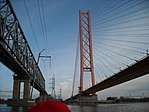  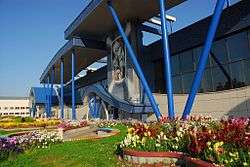 Clockwise, from top photo: Surgut City-Centre, Surgut Bridge, Surgut International Airport, Surgut State University, "Old Surgut" | |
|---|---|
City[1] | |
).png) Flag .jpg) Coat of arms | |
Location of Surgut 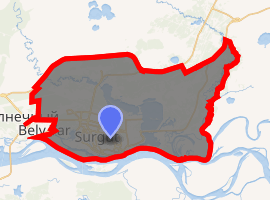
| |
 Surgut Location of Surgut 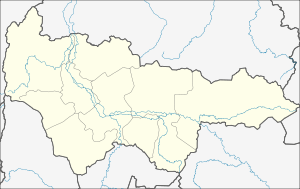 Surgut Surgut (Khanty–Mansi Autonomous Okrug) | |
| Coordinates: 61°15′N 73°26′E | |
| Country | Russia |
| Federal subject | Khanty-Mansi Autonomous Okrug[1] |
| Founded | 1594 |
| City status since | 1594-1923, June 25, 1965 |
| Government | |
| • Mayor | Vadim Shuvalov |
| Elevation | 40 m (130 ft) |
| Population | |
| • Estimate (2020) | 450,000 |
| • Subordinated to | city of okrug significance of Surgut[1] |
| • Capital of | Surgutsky District[1], city of okrug significance of Surgut[1] |
| • Urban okrug | Surgut Urban Okrug[2] |
| • Capital of | Surgut Urban Okrug[2], Surgutsky Municipal District[2] |
| Time zone | UTC+5 (MSK+2 |
| Postal code(s)[4] | 628400 |
| Dialing code(s) | +7 3462 |
| OKTMO ID | 71876000001 |
| Website | www |
History
The name of the city, according to one tradition, originates from the Khanty words "sur" (fish) and "gut" (hole, pit). It was founded in 1594 by order of Tsar Feodor I
Surgut at the end of the 16th century was a small fortress with two gates and five towers, one of which had a carriageway. In 1596 the Gostiny Dvor was built. In the 17th-18th centuries - one of the centers of the Russian development of Siberia. The fortification, built of strong wood, was located on the cape, so that it was impossible to approach it unnoticed either from the river or from the land. In the central square of the ancient settlement there was a cult place. Throughout the perimeter, the fortress was surrounded by a moat, which was blocked by the structures of the defensive system. Outside the village there were special buildings - handicraft workshops, in particular, a smithy. By the name list of 1625 there were 222 servicemen living here. Subsequently, due to high mortality, the population of Surgut gradually decreased. In 1627, 216 people lived, in 1635-200 people, in 1642-199. In the second half of the 17th century the population fluctuated around 200 people, by the end of the century there were 185 inhabitants in Surgut.
Since 1782, the county town of the Surgut district of the Tobolsk province, province, has been formed. In 1785, the city's coat of arms was approved. At the end of the 18th century, in connection with the development of southern Siberian cities, lost its administrative significance. Since 1868 - district, and since 1898 - the county town of Tobolsk province. The inhabitants of Surgut, like other Siberians, were on state security. The servants received an annual salary of money (from 5 rubles 25 kopecks), bread (8 quarters of bachelor and 11 quarters of married Cossacks) and salt (one and a half poods married and a pood with a quarter bachelor). The inhabitants were supplied with weapons and ammunition. At the end of the 19th century (according to the census of 1897), the population of Surgut was 1.1 thousand people. The main occupation of the inhabitants was fishing, gathering of wild plants, trade, cattle breeding, firewood harvesting. In 1835 the Cossack school was founded, in 1877 - the men's folk school, the women's parochial school operated, the weather station (since 1878), the library-reading room, the people's house, since 1913 - the telegraph. Since November 3, 1923 the city became the center of the district of Tobolsk district of the Ural region. Since April 5, 1926, in connection with a small population (1,3 thousand people), Surgut was transformed into a district village. In 1928, on the basis of the fish section, the first industrial enterprise was created - the fish canning factory. In 1929 a collective farm was organized, in 1930 - a forest site, in 1931 - a timber enterprise. In the 1930s in Surgut, attempts were made to extract minerals. October 23, 1934 is the first newspaper - "Organizer" ("Surgut Tribune").
The urbanization of Surgut took place in the 1960s, when it became a center of oil and gas production. On June 25, 1965 the work settlement of Surgut was granted town status. The city's holiday is celebrated annually on June 12. The current mayor is Vadim Nikolaevich Shuvalov (since 2016). Ex-mayor Alexander Sidorov (since 1996) oversaw the construction of the Surgut Bridge, the longest one-tower cable-stayed bridge in the world.
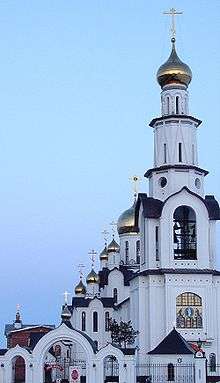
Administrative and municipal status
Within the framework of administrative divisions, it serves as the administrative center of Surgutsky District, even though it is not a part of it.[1] As an administrative division, it is incorporated separately as the city of okrug significance of Surgut—an administrative unit with the status equal to that of the districts.[1] As a municipal division, the city of okrug significance of Surgut is incorporated as Surgut Urban Okrug.[2]
Economy
The city is home to the largest port on the Ob River, the largest road/railway junction in northwest Siberia, and two of the world's most powerful power plants, the SDPP-1 (State District Power Plant 1) and SDPP-2 (State District Power Plant 2), which produce over 7,200 megawatts and supply most of the region with relatively cheap electricity.
Surgut's economy is tied to oil production (the city is known as "The Oil Capital of Russia") and the processing of natural gas. The most important enterprises are the oil firm Surgutneftegaz and Surgutgazprom (a unit of Gazprom). The Surgut-2 Power Station providing Energy for the city is the largest gas-fired power station in the world.
In Surgut, Tyumen Energy Retail Company, the largest energy sales company, is the guaranteeing supplier of electric power in the Tyumen region, ranked first in terms of the value of the productive supply of electricity among the energy distribution companies of the Urals Federal District and the second among the energy sales companies in Russia.
The management office of OJSC TESS, the largest enterprise of the Urals Federal District, is located in the city in the sphere of complex service maintenance, overhaul and reconstruction of electric power facilities.
In addition, there are factories: gas processing, stabilization of condensate, motor fuel. Enterprises food (meat processing, dairy, etc.) industry, timber industry. Manufacture of building materials (production of reinforced concrete structures, etc.).
For 2013, the volume of shipped goods of own production, works performed and services by own strength for large and medium-sized producers of industrial products amounted to 100.7 billion rubles. [47]
The structure of industrial production by types of economic activity in 2013:
"Production and distribution of electricity, gas and water" - 87.8%; "Extraction of minerals" - 6.7%; "Processing industries" - 5.5%. The average monthly salary (for large and medium-sized organizations) in 2013 amounted to 68.7 thousand rubles.
Surgut takes the 3rd place in the rating of the 250 largest industrial centers of Russia.
Transportation
The city is served by the Surgut International Airport, which offers flights to Moscow, St. Petersburg, Dubai, Irkutsk, and a number of other cities.
Through Surgut are trains to the east (in Novy Urengoy, Nizhnevartovsk), to the south-west (in Tyumen, Moscow, Novosibirsk, Ufa, Chelyabinsk, Yekaterinburg).
Road P-404 connects Surgut with Tyumen.
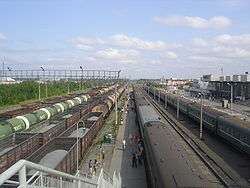
There is a port on the Ob River.
Education
As of July 1, 2016, in the city of Surgut 54 preschool institutions and 5 private kindergartens, 33 schools, 3 gymnasiums and 4 lyceums.
The system of additional education includes 4 music schools, children's choreography school, art school, 2 art studios, 10 foreign language schools (one of the schools is English-style Big Ben), 8 children's and youth sports schools, etc.
Culture
Sights
- A commemorative obelisk to the surrogates, who went to the front in 1941-1945, originally erected at the river station in 1945 in wooden execution. It was restored on May 8, 1995.
- The monument to the first members of the Komsomol of Surgut. On the monument are carved the names of the first 16 Komsomol members of Surgut, and also inscribed are the words of dedication from the youth of the 1960s. The monument plays a big role in patriotic education.
- The monument to Pushkin.
- The monument to Karl Marx.
- Monument to G. Dimitrov
- Monument to the soldiers-internationalists.
- Monument to the builder "Iron Man".
- Monument to a nurse - made at the Sverdlovsk Foundry.
- The monument to the pilots of Siberia - Mi-6 UTair is located not far from the airport.
- The monument of gas fire.
- Sculpture of a fox.
- Monument to Doctor Aybolit.
- Lenin monument.
- Historical and cultural center "Old Surgut".
- Memorial of Glory (Eternal Fire).
- The English language school, which repeats the architecture of Elizabeth Tower that houses the famous bell, Big Ben, is located near the city center.
- The Surgut bridge across the Ob River is the world's largest cable-stayed bridge, in which the central span is supported by one pylon.
- Park "Behind Saima" is a quiet romantic place among the noisy streets.
- Monument to Cyril and Methodius on the area of Sur State University.
- Monument to Taras Shevchenko.
- Monument Smile.
- Monument to condensed milk.
- 20 km to the west of the city, on the north bank of the Ob River, there is an archaeological monument of Barsov Gora.
Climate
Surgut features a continental subarctic climate (Köppen climate classification Dfc), with long and very cold winters and short but relatively warm summers. Precipitation is moderate, and is higher from May to October, when rain is more frequent, than in the rest of the year, when snow is more frequent.
| Climate data for Surgut | |||||||||||||
|---|---|---|---|---|---|---|---|---|---|---|---|---|---|
| Month | Jan | Feb | Mar | Apr | May | Jun | Jul | Aug | Sep | Oct | Nov | Dec | Year |
| Record high °C (°F) | 2.7 (36.9) |
6.5 (43.7) |
10.3 (50.5) |
23.0 (73.4) |
31.8 (89.2) |
33.5 (92.3) |
35.2 (95.4) |
30.3 (86.5) |
27.4 (81.3) |
20.7 (69.3) |
8.2 (46.8) |
2.5 (36.5) |
35.2 (95.4) |
| Average high °C (°F) | −16.3 (2.7) |
−14.2 (6.4) |
−4.8 (23.4) |
1.6 (34.9) |
10.6 (51.1) |
18.9 (66.0) |
22.4 (72.3) |
18.2 (64.8) |
10.8 (51.4) |
2.5 (36.5) |
−8.3 (17.1) |
−14.2 (6.4) |
2.3 (36.1) |
| Daily mean °C (°F) | −20.0 (−4.0) |
−18.3 (−0.9) |
−9.3 (15.3) |
−2.9 (26.8) |
5.8 (42.4) |
14.4 (57.9) |
18.2 (64.8) |
14.4 (57.9) |
7.4 (45.3) |
−0.2 (31.6) |
−11.5 (11.3) |
−18.0 (−0.4) |
−1.7 (28.9) |
| Average low °C (°F) | −23.4 (−10.1) |
−22 (−8) |
−13.6 (7.5) |
−7.1 (19.2) |
1.7 (35.1) |
10.1 (50.2) |
14.0 (57.2) |
10.8 (51.4) |
4.6 (40.3) |
−2.6 (27.3) |
−14.6 (5.7) |
−21.7 (−7.1) |
−5.3 (22.5) |
| Record low °C (°F) | −54.2 (−65.6) |
−55.2 (−67.4) |
−48.7 (−55.7) |
−39.7 (−39.5) |
−22 (−8) |
−6.7 (19.9) |
−0.1 (31.8) |
−3.7 (25.3) |
−10.5 (13.1) |
−30.7 (−23.3) |
−46.9 (−52.4) |
−55 (−67) |
−55.2 (−67.4) |
| Average precipitation mm (inches) | 25 (1.0) |
22 (0.9) |
28 (1.1) |
34 (1.3) |
58 (2.3) |
57 (2.2) |
76 (3.0) |
69 (2.7) |
85 (3.3) |
55 (2.2) |
39 (1.5) |
32 (1.3) |
580 (22.8) |
| Average rainy days | 0.3 | 0.1 | 1 | 6 | 12 | 14 | 12 | 15 | 15 | 12 | 3 | 1 | 91.4 |
| Average snowy days | 22 | 18 | 15 | 9 | 4 | 1 | 0 | 0 | 1 | 11 | 20 | 23 | 124 |
| Average relative humidity (%) | 81 | 79 | 75 | 69 | 65 | 65 | 67 | 76 | 79 | 84 | 84 | 82 | 76 |
| Mean monthly sunshine hours | 31 | 95 | 147 | 218 | 252 | 261 | 311 | 217 | 136 | 70 | 46 | 23 | 1,807 |
| Source 1: Pogoda.ru.net[8] | |||||||||||||
| Source 2: NOAA (sun only, 1961-1990)[9] | |||||||||||||
Sports
Sports and recreation complexes "Friendship", "Fakel", "Neftyanik" are known far beyond the city limits, they hold high-level sports competitions. In 2006, they added a multifunctional sports complex "Sparta". The construction of the stadium was started.
In 2009, the city of Surgut ranked 2nd in terms of socio-economic development of the municipal formations of the Khanty-Mansiysk Autonomous Okrug - Ugra in the field of "Physical Culture and Sport" and the third place in terms of the effectiveness of the use of sports facilities among the municipalities of the district.
Sport Club:
- Universitet Surgut, basketball team playing in the Russian Basketball Super League
- Gazprom-Yugra is a men's volleyball club competing in the Russian Volleyball Super League and playing its home matches at the Premier Arena
Coat of arms
The modern coat of arms of Surgut, "in the golden field - a black fox with a silver tail end, walking along the azure land", was approved on November 20, 2003 by the decision of the city duma of November 4, 2003.
Twin towns – sister cities



Notable people
- Igor Bobkov (born 1991), ice hockey goaltender
- Isolda Dychauk (born 1993), actress
- Pavel Ivashko (born 1994), sprinter
- Ksenia Klimenko (born 2003), artistic gymnast
- Andrei Kolegayev (1887–1937), Left Socialist-Revolutionary, Soviet politician
- Aleksandr Kolomeytsev (born 1989), football player
- Yelena Terleyeva (born 1985), pop singer
- Miroslava Duma (born 1985)
Gallery
 Park near the Saima river
Park near the Saima river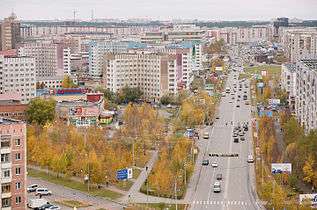 Surgut at the end of September
Surgut at the end of September.jpg) SDPP-2
SDPP-2
See also
References
Notes
- Law #43-oz
- Law #63-oz
- "Об исчислении времени". Официальный интернет-портал правовой информации (in Russian). June 3, 2011. Retrieved January 19, 2019.
- Почта России. Информационно-вычислительный центр ОАСУ РПО. (Russian Post). Поиск объектов почтовой связи (Postal Objects Search) (in Russian)
- Russian Federal State Statistics Service (2011). "Всероссийская перепись населения 2010 года. Том 1" [2010 All-Russian Population Census, vol. 1]. Всероссийская перепись населения 2010 года [2010 All-Russia Population Census] (in Russian). Federal State Statistics Service.
- Russian Federal State Statistics Service (May 21, 2004). "Численность населения России, субъектов Российской Федерации в составе федеральных округов, районов, городских поселений, сельских населённых пунктов – районных центров и сельских населённых пунктов с населением 3 тысячи и более человек" [Population of Russia, Its Federal Districts, Federal Subjects, Districts, Urban Localities, Rural Localities—Administrative Centers, and Rural Localities with Population of Over 3,000] (XLS). Всероссийская перепись населения 2002 года [All-Russia Population Census of 2002] (in Russian).
- "Всесоюзная перепись населения 1989 г. Численность наличного населения союзных и автономных республик, автономных областей и округов, краёв, областей, районов, городских поселений и сёл-райцентров" [All Union Population Census of 1989: Present Population of Union and Autonomous Republics, Autonomous Oblasts and Okrugs, Krais, Oblasts, Districts, Urban Settlements, and Villages Serving as District Administrative Centers]. Всесоюзная перепись населения 1989 года [All-Union Population Census of 1989] (in Russian). Институт демографии Национального исследовательского университета: Высшая школа экономики [Institute of Demography at the National Research University: Higher School of Economics]. 1989 – via Demoscope Weekly.
- "Pogoda.ru.net" (in Russian). Retrieved January 18, 2013.
- "Climate Normals for Surgut". National Oceanic and Atmospheric Administration. Retrieved January 18, 2013.
- "Партнеры Сургута". admsurgut.ru (in Russian). Surgut. Retrieved February 5, 2020.
Sources
- Дума Ханты-Мансийского автономного округа — Югры. Закон №43-оз от 7 июля 2004 г. «Об административно-территориальном устройстве Ханты-Мансийского автономного округа — Югры и порядке его изменения», в ред. Закона №129-оз от 9 декабря 2015 г. «Об изменениях административно-территориального устройства Ханты-Мансийского автономного округа — Югры и о внесении изменений в отдельные Законы Ханты-Мансийского автономного округа — Югры». Вступил в силу по истечении десяти дней со дня официального опубликования. Опубликован: "Новости Югры", №83, 17 июля 2004 г. (Duma of Khanty-Mansi Autonomous Okrug—Yugra. Law #43-oz of July 7, 2004 On the Administrative-Territorial Structure of Khanty-Mansi Autonomous Okrug—Yugra and on the Procedures for Its Change, as amended by the Law #129-oz of December 9, 2015 On the Changes to the Administrative-Territorial Structure of Khanty-Mansi Autonomous Okrug—Yugra and on Amending Various Laws of Khanty-Mansi Autonomous Okrug—Yugra. Effective as of the day which after ten days after the official publication date.).
- Дума Ханты-Мансийского автономного округа — Югры. Закон №63-оз от 25 ноября 2004 г. «О статусе и границах муниципальных образований Ханты-Мансийского автономного округа — Югры», в ред. Закона №129-оз от 9 декабря 2015 г. «Об изменениях административно-территориального устройства Ханты-Мансийского автономного округа — Югры и о внесении изменений в отдельные Законы Ханты-Мансийского автономного округа — Югры». Вступил в силу по истечении десяти дней со дня официального опубликования и до 1 января 2006 года применяется в целях реализации статей 84, 85 Федерального закона от 06.10.2003 №131-ФЗ. Опубликован: "Новости Югры", №143, 7 декабря 2004 г. (Duma of Khanty-Mansi Autonomous Okrug—Yugra. Law #63-oz of November 25, 2004 On the Status and Borders of the Municipal Formations of Khanty-Mansi Autonomous Okrug—Yugra, as amended by the Law #129-oz of December 9, 2015 On the Changes to the Administrative-Territorial Structure of Khanty-Mansi Autonomous Okrug—Yugra and on Amending Various Laws of Khanty-Mansi Autonomous Okrug—Yugra. Effective as of the day which after ten days after the official publication date; also in effect until January 1, 2006 in order to meet the requirements of Articles 84, 85 of the Federal Law #131-FZ of October 6, 2003.).
External links
- Official website of Surgut (in Russian)
- (in Russian) Informational website of Surgut
.jpg)